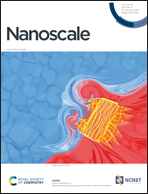Attaining inhibition of sneak current and versatile logic operations in a singular halide perovskite memristive device by introducing appropriate interface barriers†
Abstract
Emerging resistive switching devices hold the potential to realize densely packed passive nanocrossbar arrays, suitable for deployment as random access memory devices (ReRAMs) in both embedded and high-capacity storage applications. In this study, we have engineered ReRAMs comprising ITO/(UVO-treated) amorphous ZnO (a-ZnO)/MAPbI3/Ag which effectively mitigate cross-talk currents without additional components. Significantly, we successfully executed a comprehensive set of 12 distinct 2-input sequential logic functions in a single halide perovskite ReRAM unit for the first time. Furthermore, these logic functions are devoid of any dependency on external light sources, entail merely 1 or 2 logic steps, and showcase symmetrical operability. A superior resistive switching behavior was achieved by harmonizing the charge transport within the bulk MAPbI3 and the tunneling barriers at the interfaces. The outcomes indicate progress in mitigating cross-talk and executing multiple logic functions within a single halide perovskite ReRAM unit, offering a new perspective for the advancement of halide perovskite ReRAMs.



 Please wait while we load your content...
Please wait while we load your content...